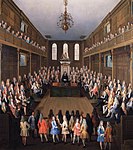Statue of Margaret Thatcher (Palace of Westminster)
2007 sculpturesBronze sculptures in the United KingdomMonuments and memorials in LondonMonuments and memorials to womenPalace of Westminster ... and 3 more
Sculptures of women in the United KingdomStatues in the City of WestminsterStatues of Margaret Thatcher

A statue of Margaret Thatcher, the first female prime minister of the United Kingdom, stands in the Members' Lobby of the Houses of Parliament in London. It is a bronze sculpture of Margaret Thatcher, the first female Prime Minister of the United Kingdom. It was commissioned in 2003 following a change in rules to allow the depiction of living prime ministers in Parliament under certain conditions. The bronze statue, sculpted by Antony Dufort, was unveiled on 21 February 2007 by Michael Martin, Speaker of the House of Commons, with Thatcher in attendance.
Excerpt from the Wikipedia article Statue of Margaret Thatcher (Palace of Westminster) (License: CC BY-SA 3.0, Authors, Images).Statue of Margaret Thatcher (Palace of Westminster)
New Palace Yard, London Lambeth
Geographical coordinates (GPS) Address Website Nearby Places Show on map
Geographical coordinates (GPS)
| Latitude | Longitude |
|---|---|
| N 51.4997 ° | E -0.1248 ° |
Address
Palace of Westminster (Houses of Parliament)
New Palace Yard
SW1A 0AA London, Lambeth
England, United Kingdom
Open on Google Maps









